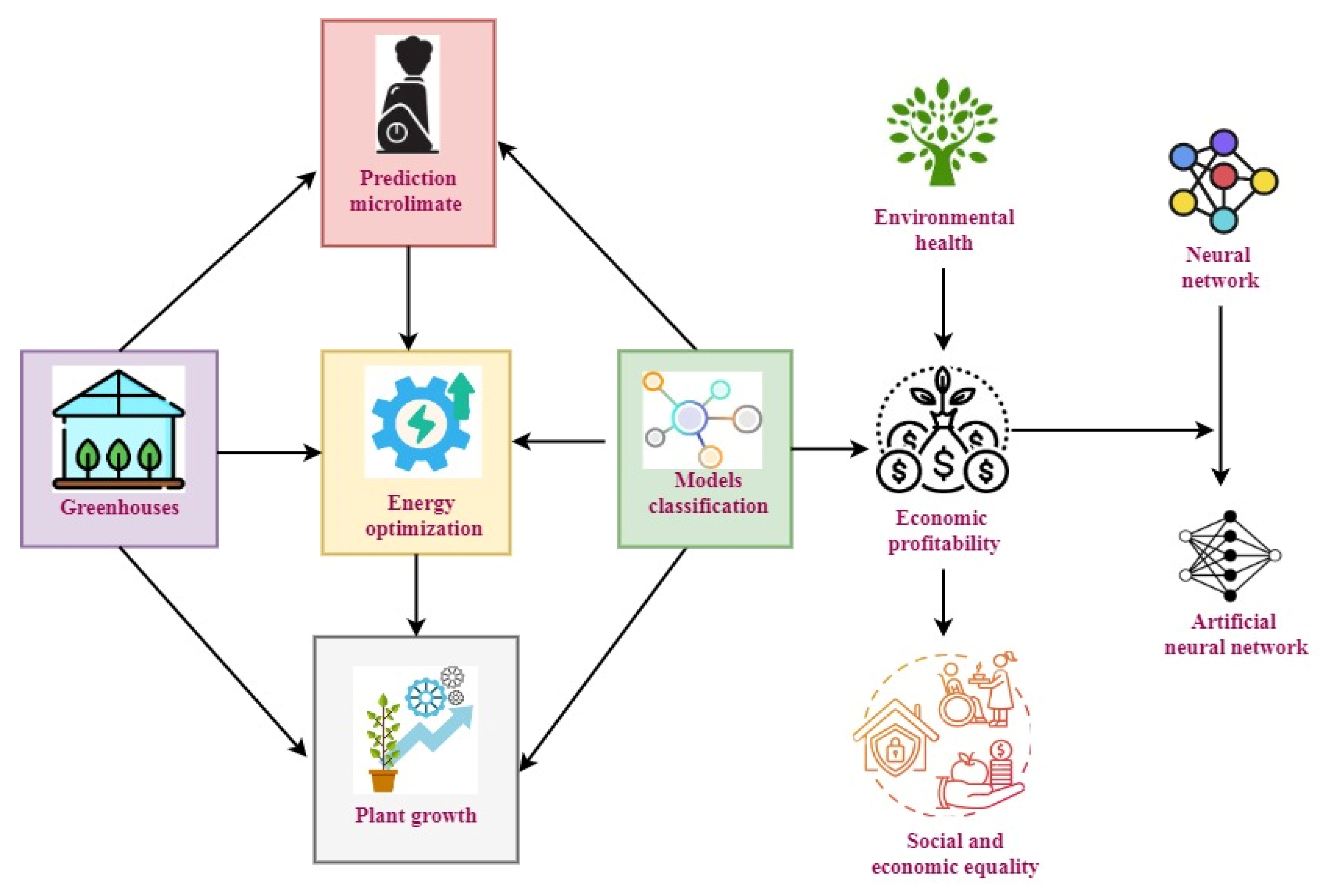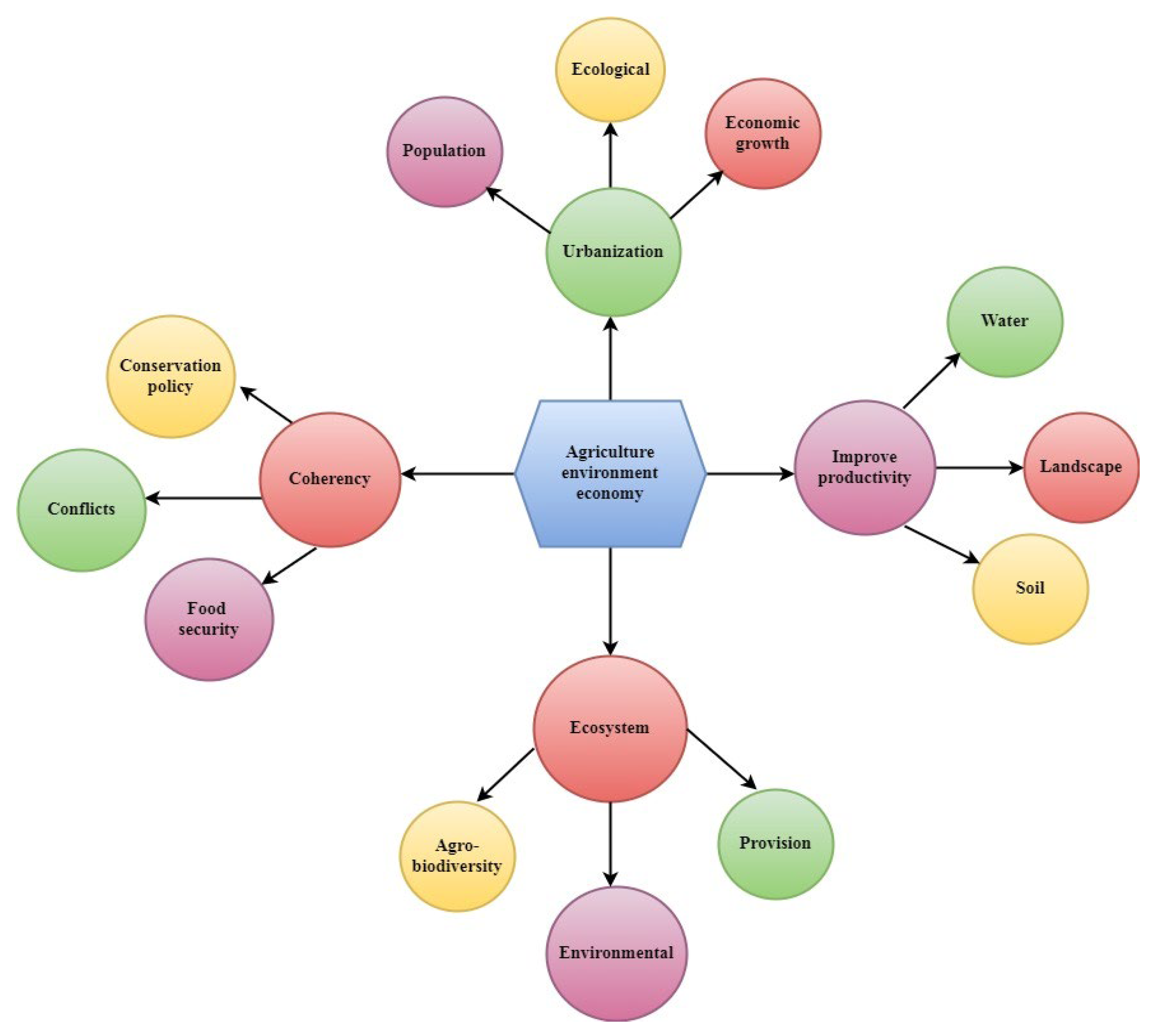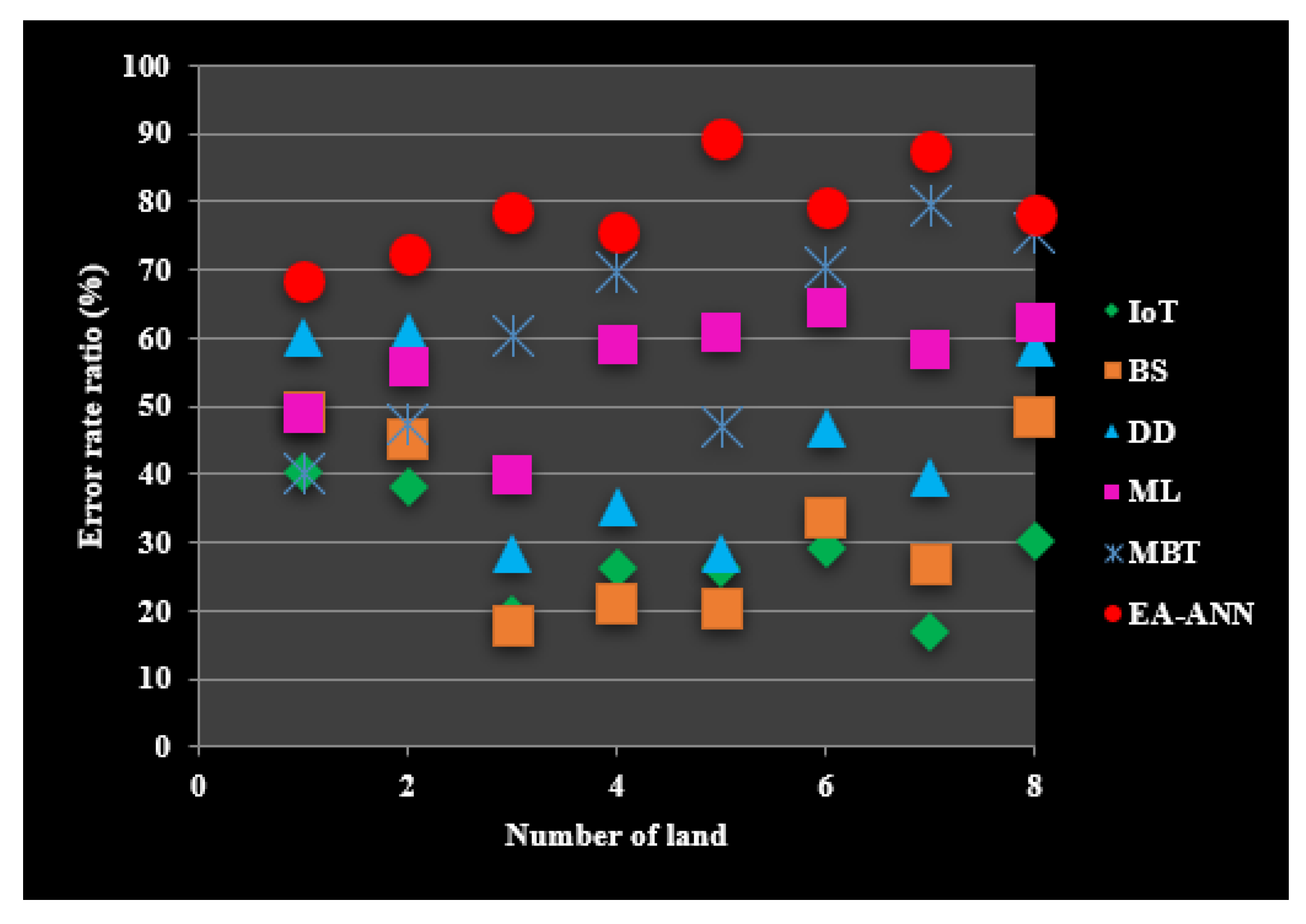Analysis of Development Strategy for Ecological Agriculture Based on a Neural Network in the Environmental Economy
Abstract
1. Introduction
- Conduct agriculture research into the production, treatment, and management of an agricultural product, including research needed for a better knowledge of the processes or the environment essential for developing an economy.
- Enhanced harvest success can largely be attributed to ecological farming’s many benefits, including, most notably, increased pollination. Environmental farming is a technique that employs natural ecosystem services, such as pollination, water purification, oxygen creation, and insect damage control.
- The ecological economic idea is developed from assessing commercial markets’ inability to provide sufficient environmental goods. As a result, the research emphasizes how these people can increase wellbeing besides impeding in industry sectors.
- Smart farming uses ANN systems to increase harvest quality and accuracy. Assist EA-ANN in detecting plant diseases and insufficient pest nutrition using ANN technology. In addition, it enables farmers to keep an eye on the health of their crops and the surrounding soil.
2. The Literature Survey
3. Ecological Agriculture on Environment Economy Based on Neural Network
3.1. Ecological Agriculture in Artificial Neural Network
3.2. Framework of Ecological Agriculture
3.3. Overview of Ecological Agriculture Economies
4. Result and Discussion of the Ecological Agriculture Environment Economy
5. Conclusions
Funding
Institutional Review Board Statement
Informed Consent Statement
Data Availability Statement
Conflicts of Interest
References
- Zhang, M.; Zhang, C.; Kafy, A.A.; Tan, S. Simulating the Relationship between Land Use/Cover Change and Urban Thermal Environment Using Machine Learning Algorithms in Wuhan City, China. Land 2021, 11, 14. [Google Scholar] [CrossRef]
- Edwards, C.A. The Importance of Integration in Sustainable Agricultural Systems. In Sustainable Agricultural Systems; CRC Press: Boca Raton, FL, USA, 2020; pp. 249–264. [Google Scholar]
- Thakur, N.; Kaur, S.; Tomar, P.; Thakur, S.; Yadav, A.N. Microbial Biopesticides: Current Status and Advancement for Sustainable Agriculture and Environment. In New and Future Developments in Microbial Biotechnology and Bioengineering; Elsevier: Amsterdam, The Netherlands, 2020; pp. 243–282. [Google Scholar]
- Adegbeye, M.J.; Reddy, P.R.K.; Obaisi, A.I.; Elghandour, M.M.M.Y.; Oyebamiji, K.J.; Salem, A.Z.M.; Camacho-Díaz, L.M. Sustainable Agriculture Options for Production, Greenhouse Gasses and Pollution Alleviation and Nutrient Recycling in Emergingand Transitional Nations-an Overview. J. Clean. Prod. 2020, 242, 118319. [Google Scholar] [CrossRef]
- Torres, M.A.O.; Kallas, Z.; Herrera, S.I.O. Farmers’ Environmental Perceptions and Preferences Regarding Climate Change Adaptation and Mitigation Actions; Towards a Sustainable Agricultural System in México. Land Use Policy 2020, 99, 105031. [Google Scholar] [CrossRef]
- Mottet, A.; Bicksler, A.; Lucantoni, D.; De Rosa, F.; Scherf, B.; Scopel, E.; Tittonell, P. Assessing Transitions to Sustainable Agricultural and Food Systems: A Tool for Agroecology Performance Evaluation (TAPE). Front. Sustain. Food Syst. 2020, 4, 579154. [Google Scholar] [CrossRef]
- Gołaś, M.; Sulewski, P.; Wąs, A.; Kłoczko-Gajewska, A.; Pogodzińska, K. on the Way to Sustainable Agriculture—Eco-Efficiency of Polish Commercial Farms. Agriculture 2020, 10, 438. [Google Scholar] [CrossRef]
- Zeweld, W.; Van Huylenbroeck, G.; Tesfay, G.; Azadi, H.; Speelman, S. Sustainable Agricultural Practices, Environmental Risk Mitigation and Livelihood Improvements: Empirical Evidence from Northern Ethiopia. Land Use Policy 2020, 95, 103799. [Google Scholar] [CrossRef]
- Iocola, I.; Angevin, F.; Bockstaller, C.; Catarino, R.; Curran, M.; Messéan, A.; Canali, S. An Actor-Oriented Multi-Criteria Assessment Framework to Support a Transition towards Sustainable Agricultural Systems Based on Crop Diversification. Sustainability 2020, 12, 5434. [Google Scholar] [CrossRef]
- El Chami, D.; Daccache, A.; El Moujabber, M. How can Sustainable Agriculture Increase Climate Resilience? A Systematic Review. Sustainability 2020, 12, 3119. [Google Scholar] [CrossRef]
- Gebska, M.; Grontkowska, A.; Swiderek, W.; Golebiewska, B. Farmer Awareness and Implementation of Sustainable Agriculture Practices in Different Types of Farms in Poland. Sustainability 2020, 12, 8022. [Google Scholar] [CrossRef]
- Santiteerakul, S.; Sopadang, A.; Yaibuathet Tippayawong, K.; Tamvimol, K. The Role of Smart Technology in Sustainable Agriculture: A Case Study of Wangree Plant Factory. Sustainability 2020, 12, 4640. [Google Scholar] [CrossRef]
- Yadav, A.N. Plant Microbiomes for Sustainable Agriculture: Current Research and Future Challenges; Springer International Publishing: Amsterdam, The Netherlands, 2020; pp. 475–482. [Google Scholar]
- Sun, J.; Li, Y.P.; Suo, C.; Liu, J. Development of an Uncertain Water-Food-Energy Nexus Model for Pursuing Sustainable Agricultural and Electric Productions. Agric. Water Manag. 2020, 241, 106384. [Google Scholar] [CrossRef]
- Jerzak, M.A.; Śmiglak-Krajewska, M. Globalization of the Market for Vegetable Protein Feed and Its Impact on Sustainable Agricultural Development and Food Security in EU Countries Illustrated by the Example of Poland. Sustainability 2020, 12, 888. [Google Scholar] [CrossRef]
- Pretty, J.; Attwood, S.; Bawden, R.; Van Den Berg, H.; Bharucha, Z.P.; Dixon, J.; Yang, P. Assessment of the Growth in Social Groups for Sustainable Agriculture and Land Management. Glob. Sustain. 2020, 3, e23. [Google Scholar] [CrossRef]
- Foguesatto, C.R.; Borges, J.A.R.; Machado, J.A.D. A Review and Some Reflections on Farmers’ Adoption of Sustainable Agricultural Practices Worldwide. Sci. Total Environ. 2020, 729, 138831. [Google Scholar] [CrossRef]
- Adedeji, A.A.; Häggblom, M.M.; Babalola, O.O. Sustainable Agriculture in Africa: Plant Growth-Promoting Rhizobacteria (PGPR) to the Rescue. Sci. Afr. 2020, 9, e00492. [Google Scholar] [CrossRef]
- Chittora, D.; Meena, M.; Barupal, T.; Swapnil, P.; Sharma, K. Cyanobacteria as a Source of Biofertilizers for Sustainable Agriculture. Biochem. Biophys. Rep. 2020, 22, 100737. [Google Scholar] [CrossRef]
- Skrimizea, E.; Lecuyer, L.; Bunnefeld, N.; Butler, J.R.; Fickel, T.; Hodgson, I.; Young, J.C. Sustainable agriculture: Recognizing the potential of conflict as a positive driver for transformative change. Adv. Ecol. Res. 2020, 63, 255–311. [Google Scholar]
- Khan, N.; Ray, R.L.; Sargani, G.R.; Ihtisham, M.; Khayyam, M.; Ismail, S. Current Progress and Future Prospects of Agriculture Technology: Gateway to Sustainable Agriculture. Sustainability 2021, 13, 4883. [Google Scholar] [CrossRef]
- Ali, Q.; Ahmar, S.; Sohail, M.A.; Kamran, M.; Ali, M.; Saleem, M.H.; Ali, S. Research Advances and Applications of Biosensing Technology for the Diagnosis of Pathogens in Sustainable Agriculture. Environ. Sci. Pollut. Res. 2021, 28, 9002–9019. [Google Scholar] [CrossRef]
- Kamble, S.S.; Gunasekaran, A.; Gawankar, S.A. Achieving Sustainable Performance in a Data-Driven Agriculture Supply Chain: A Review for Research and Applications. Int. J. Prod. Econ. 2020, 219, 179–194. [Google Scholar] [CrossRef]
- Sharma, R.; Kamble, S.S.; Gunasekaran, A.; Kumar, V.; Kumar, A. A Systematic Literature Review on Machine Learning Applications for Sustainable Agriculture Supply Chain Performance. Comput. Oper. Res. 2020, 119, 104926. [Google Scholar] [CrossRef]
- Yadav, A.N.; Kour, D.; Kaur, T.; Devi, R.; Guleria, G.; Rana, K.L.; Rastegari, A.A. Microbial Biotechnology for Sustainable Agriculture: Current Research and Future Challenges. In New and Future Developments in Microbial Biotechnology and Bioengineering; Elsevier: Amsterdam, The Netherlands, 2020; pp. 331–344. [Google Scholar]
- Chen, S.; Li, B.; Cao, J.; Mao, B. Research on agricultural environment prediction based on deep learning. Procedia Comput. Sci. 2018, 139, 33–40. [Google Scholar] [CrossRef]
- Nguyen, N.; Drakou, E.G. Farmers’ Intention to Adopt Sustainable Agriculture Hinges on Climate Awareness: The Case of Vietnamese Coffee. J. Clean. Prod. 2021, 303, 126828. [Google Scholar] [CrossRef]
- Shende, S.; Rajput, V.D.; Gade, A.; Minkina, T.; Fedorov, Y.; Sushkova, S.; Boldyreva, V. Metal-Based Green Synthesized Nanoparticles: Boon for Sustainable Agriculture and Food Security. IEEE Trans. Nanobiosci. 2021, 21, 44–54. [Google Scholar] [CrossRef]
- Poveda, J. Insect Frass in the Development of Sustainable Agriculture. A Review. Agron. Sustain. Dev. 2021, 41, 5. [Google Scholar] [CrossRef]
- Do Espirito Santo Pereira, A.; Caixeta Oliveira, H.; Fernandes Fraceto, L.; Santaella, C. Nanotechnology Potential in Seed Priming for Sustainable Agriculture. Nanomaterials 2021, 11, 267. [Google Scholar] [CrossRef]
- Mishenin, Y.; Yarova, I.; Koblianska, I. Ecologically Harmonized Agricultural Management for Global Food Security. In Ecological Intensification of Natural Resources for Sustainable Agriculture; Springer: Singapore, 2021; pp. 29–76. [Google Scholar]
- Abiodun, O.I.; Jantan, A.; Omolara, A.E.; Dada, K.V.; Mohamed, N.A.; Arshad, H. State-of-the-art in artificial neural network applications: A survey. Heliyon 2018, 4, e00938. [Google Scholar] [CrossRef]
- Shaikh, T.A.; Rasool, T.; Lone, F.R. Towards leveraging the role of machine learning and artificial intelligence in precision agriculture and smart farming. Comput. Electron. Agric. 2022, 198, 107119. [Google Scholar] [CrossRef]
- Wang, L.; Wang, Y.; Chen, J. Assessment of the ecological niche of photovoltaic agriculture in China. Sustainability 2019, 11, 2268. [Google Scholar] [CrossRef]
- Zhang, M.; Kafy, A.A.; Xiao, P.; Han, S.; Zou, S.; Saha, M.; Zhang, C.; Tan, S. Impact of urban expansion on land surface temperature and carbon emissions using machine learning algorithms in Wuhan, China. Urban Clim. 2023, 47, 101347. [Google Scholar] [CrossRef]






| Number of Lands | IoT | BS | DD | ML | MBT | EA-ANN |
|---|---|---|---|---|---|---|
| 1 | 23.8 | 18.8 | 17.5 | 36.5 | 57.5 | 71.2 |
| 2 | 19.2 | 29.2 | 31.5 | 23.5 | 50.4 | 66.4 |
| 3 | 22.6 | 31.6 | 19.1 | 38.6 | 54.5 | 60.5 |
| 4 | 13.8 | 23.8 | 34.3 | 45.1 | 59.3 | 73.2 |
| 5 | 31.9 | 21.9 | 30.2 | 51.9 | 67.5 | 72.7 |
| 6 | 26.6 | 16.6 | 31.2 | 53.5 | 77.6 | 95.2 |
| 7 | 35.5 | 37.5 | 42.8 | 62.4 | 75.3 | 84.4 |
| 8 | 20.7 | 49.7 | 37.5 | 54.3 | 78.3 | 92.4 |
| Number of Lands | IoT | BS | DD | ML | MBT | EA-ANN |
|---|---|---|---|---|---|---|
| 1 | 26.5 | 19.8 | 41.5 | 36.5 | 57.5 | 60.2 |
| 2 | 29.2 | 19.2 | 31.5 | 49.5 | 32.4 | 50.4 |
| 3 | 16.6 | 25.6 | 39.1 | 57.6 | 50.5 | 70.5 |
| 4 | 19.8 | 17.8 | 29.3 | 39.1 | 56.3 | 68.2 |
| 5 | 35.9 | 29.9 | 36.2 | 55.9 | 68.5 | 78.7 |
| 6 | 39.6 | 19.6 | 37.2 | 49.5 | 67.6 | 85.2 |
| 7 | 30.5 | 32.5 | 42.8 | 59.4 | 70.3 | 76.4 |
| 8 | 15.7 | 29.7 | 39.5 | 58.3 | 79.3 | 90.4 |
Disclaimer/Publisher’s Note: The statements, opinions and data contained in all publications are solely those of the individual author(s) and contributor(s) and not of MDPI and/or the editor(s). MDPI and/or the editor(s) disclaim responsibility for any injury to people or property resulting from any ideas, methods, instructions or products referred to in the content. |
© 2023 by the author. Licensee MDPI, Basel, Switzerland. This article is an open access article distributed under the terms and conditions of the Creative Commons Attribution (CC BY) license (https://creativecommons.org/licenses/by/4.0/).
Share and Cite
Cheng, Y. Analysis of Development Strategy for Ecological Agriculture Based on a Neural Network in the Environmental Economy. Sustainability 2023, 15, 6843. https://doi.org/10.3390/su15086843
Cheng Y. Analysis of Development Strategy for Ecological Agriculture Based on a Neural Network in the Environmental Economy. Sustainability. 2023; 15(8):6843. https://doi.org/10.3390/su15086843
Chicago/Turabian StyleCheng, Yi. 2023. "Analysis of Development Strategy for Ecological Agriculture Based on a Neural Network in the Environmental Economy" Sustainability 15, no. 8: 6843. https://doi.org/10.3390/su15086843
APA StyleCheng, Y. (2023). Analysis of Development Strategy for Ecological Agriculture Based on a Neural Network in the Environmental Economy. Sustainability, 15(8), 6843. https://doi.org/10.3390/su15086843




